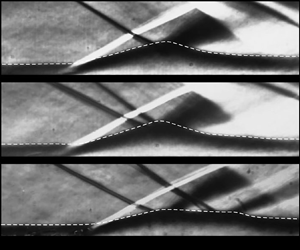Article contents
Comparative study on single-incident and dual-incident shock wave/turbulent boundary layer interactions with identical total deflection angle
Published online by Cambridge University Press: 05 April 2022
Abstract

Interactions between the boundary layer and two successive incident shock waves (ISWs) often occur in the supersonic mixed-compression inlets. However, the flow mechanism involved in such interactions has been studied rarely. In this study, we investigate experimentally and analytically the turbulent boundary layer separation flow induced by the single ISW and dual ISWs at the identical total deflection angles in a Mach 2.73 flow. Schlieren photography, wall pressure measurement and surface oil-flow visualisation are employed to diagnose the flow field. Experiments with the impingement points of the two ISWs intersecting on the bottom wall exhibit a separated flow with a triangle-like separation bubble, namely the first kind of dual-ISW/turbulent boundary layer interaction (ISWTBLI). Comparative studies show that various flow features of this kind of dual-ISWTBLI, including the extent of the separation region, pressure distribution and surface-flow topological structures, are nearly identical to those of the single-ISWTBLI with an identical total deflection angle. As the distance between the two ISWs increases, the shape of the separation region in the dual-ISWTBLI changes from triangle-like to quadrilateral-like, and the height of the separation region decreases accordingly, forming the second kind of dual-ISWTBLI. Furthermore, an inviscid model is developed for the dual-ISWTBLI to describe the complex shock wave system and elucidate the cause of a quadrilateral-like separation bubble in the second kind of dual-ISWTBLI. Moreover, based on a previous work by Souverein et al. (J. Fluid Mech., vol. 714, 2013, pp. 505–535) on the single-ISWTBLI, a modified scaling method is established for the first kind of dual-ISWTBLI.
- Type
- JFM Papers
- Information
- Copyright
- © The Author(s), 2022. Published by Cambridge University Press
References
REFERENCES
- 8
- Cited by





